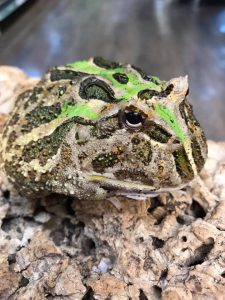Copyright 2021 Evolution Reptiles
All rights reserved.
Copyright 2025 Evolution Reptiles
All rights reserved.
All rights reserved.
There are two commonly encountered species that are given the common name interchangeably; the Chacoan horned frog (Ceratophrys cranwelli), and the Argentine wide mouth frog (Ceratophrys ornata). Care for both of these species is identical and they are found in almost overlapping territories in the wild, occurring across the dry grasslands of Argentina, Uruguay, Paraguay, Bolivia and Brazil. They are large frogs, ranging from 8 – 15cm snout to vent length, and can reach weights of half a kilo. These are amongst the heavy hitters of the amphibian world!

The name ‘horned frog’ comes from the little fleshy peaks over their upper eyelids. In these two species they are not particularly large, but in the closely related Surinam horned frog (C. cornuta) they are large and sharply pointed.
Patterned in brown, yellow, black, white and green, the cranwelli usually sports a classic ‘camouflage’ look, whereas the colours on the ornata are sharper, appearing almost painted in appearance. Albino specimens are available, and some breeders specialise in developing different colour strains as well as pattern morphs. When two different species are crossed (such as cranwelli x ornata or cranwelli x cornuta) these are known as fantasy horned frogs, and exhibit an astonishing range of patterns and colours outside of the wild-type frogs more usually available.
The horned frogs are renowned for their powerful bite, and unlike many frogs, horned frogs have teeth. They have a row of needle sharp, recurved pegs in the upper jaw, and several tooth like projections (known as ‘odontoid projections’) on the lower jaw that act like long, sharp teeth and ensure that once prey is grabbed with the very sticky tongue, it has no chance of escape.
Horned frogs are ambush hunters. They spend most of their time half buried in soft, damp soil, and wait for their next meal to wander past – and as they will tackle prey items up to their own size, that meal could be an insect, lizard, snake, bird or rodent! Keep your feeding regime to insects, and tong feed where possible in order to avoid your frog ingesting substrate. Make sure to dust the food with a good calcium or multivitamin/multimineral supplement.
Despite their sedentary lifestyle, these frogs do need a fairly large living space once they reach adulthood. A glass terrarium of at least 60 x 45 x 30cm (L x D x H) suits them very well, although larger is always better. Heating should be provided by a thermostatically controlled deep heat projector, and like the vast majority of amphibians they do appear to benefit from the presence of UVB light which can be provided by a low output T5 UVB unit. Aim for a temperature of 23 to 29ºC (75 to 85ºF), with a slight temperature drop at night, and always use a digital thermometer to check your temperatures. If they become too cool or dry, your frog will surround themself with a tough waterproof mucus within which they think they can wait for the wet season to return. Check your temperatures and moisture levels, and your frog should wake up and begin eating again.
Use a substrate that will hold moisture, but don’t allow it to become too wet; your frog will like to dig their own cavities within it, so be sure to make it deep enough for digging. Provide a water bowl, but keep it shallow – these frogs will drown in deep water!
Copyright 2021 Evolution Reptiles
All rights reserved.